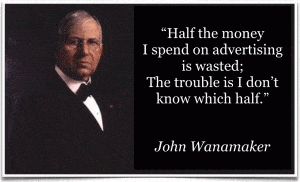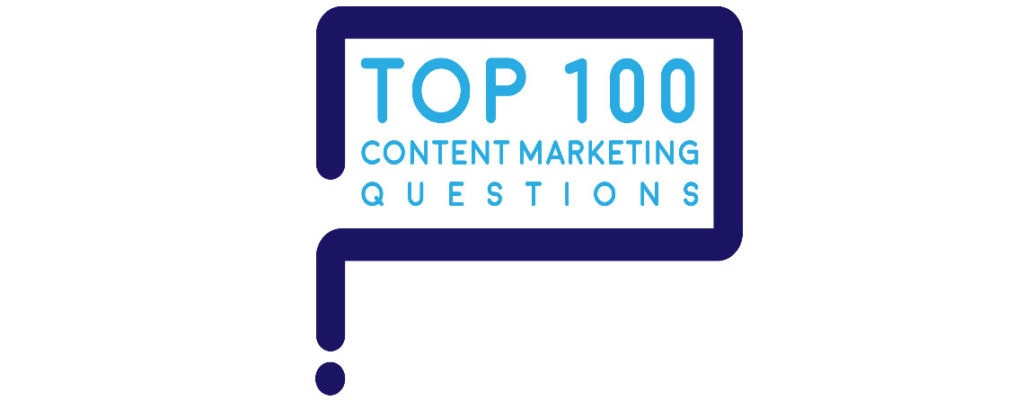
Top 100 Content Marketing Question: How do you start a content marketing program from scratch?
Start content marketing where you are. Here’s how in 10 easy steps.
To start up content marketing, first adopt the right mindset: See the world through the eyes of buyers.
Resolve to become the best teacher your customers can find on the Internet. How? Take these 10 steps:
1. Collect insights on buyer personas.
Interview customers by phone or face to face to gain 5 key insights about your buyers:
- Priority Initiatives: Peer into the genesis of buyers’ decisions to make a change. What were triggering events and pain points? Who set buyers’ decision-making into motion? What pushed them to set out on a buying journey?
- Success Factors: See why buyers keep moving forward. What positive changes did buyers expect to gain? What would change for them in terms of practical outcomes, business outcomes, and buyers’ personal aspirations?
- Perceived Barriers: Discover the obstacles that buyers encounter – and must resolve. What prevented buyers from addressing the problem(s) sooner? Did someone get in the way? Did previous negative experiences cause buyers to shy away? Were needed capabilities missing from the considered solutions?
- Decision Criteria: Peer into the “what and how” of buying decisions. Which specific features or capabilities were most important to buyers during the buying journey? What exactly did buyers want to learn? Where did they search for information — peers, experts, trade media, websites, social media?
- Buyer’s Journey: Observe the internal workings of teams behind buying decisions. Who has input, who’s the recommender and who’s the decision-maker for the purchase? Who else was involved? What did buyers do to evaluate options? What are the learning habits of various team members?
2. Find out: what are your customers’ top 100 questions?

Gather customer questions, in their own words, to learn the answers they seek and the topics they want to know more about.
Here are 14 ways to gather customer questions. Choose one or more that fit your company’s needs. Gather at least 1,000 questions, then perform a text analysis to determine which questions are most important.
With the insights from your buyer persona research and the knowledge of your customers’ most important questions, you can begin to create breakthrough content. Address one topic at a time on each webpage.
Distinguish your answers from competitors’ answers. Make sure your content is superior to competitors in one or more dimensions:
- Provide simpler answers to customers’ questions.
- Create content that’s more visual with photos or videos.
- Provide a more complete library of resources for your customers.
- Make your content mobile-responsive.
- Offer content that’s quicker to consume, like Bart’s Fish Tales, a series of 15-second cooking videos.
- Offer long-form content, such as a white paper or e-book that will take 20 minutes or more to read – especially for carefully considered purchases.
- Find an expert in your company who can become the face of a topic that customers are interested in. Once you establish your expert and your message, it’s easy to generate blogs, podcasts, videos, and live events.
- Help your customers find happy customers who look like them.
Don’t create a single FAQ page that lumps all your customers’ questions together. Why? Because Google will not be able to determine the page’s main topic, so the page will not rank highly in search.
Take Andy Crestodina’s advice – search for and tackle your industry’s hardest question. Ask:
- What is the one question that no one in your industry will answer?
- What is the one accepted idea in your industry that lacks evidence?
3. Map content to the buyers’ journey.

Use your buyer persona insights and questions to map your buyers’ journey. For consumers, buyers’ journeys can range from an impulsive purchase of a soda to a high-dollar, carefully considered purchase such as a car, a home or a retirement plan.
In carefully considered, high-value B2B purchasing, buyers take 4 distinct steps. At each step, buyers ask different kinds of questions, seek different kinds of information, and prefer to use different media. See more on the B2B buyers’ journey here.
4. Audit your existing content.
Inventory the company assets you have that you can repurpose for content marketing, such as:
- Marketing collateral
- Web pages
- Case histories
- Videos
- White papers
- Social media
- Newsletters or magazines
- Trade shows and events
- Lists of customer questions (from sales and service)
- Subject-matter experts (to blog and post)
- Heavy social media users (who can become ambassadors for your content).
In the process of a content inventory, most marketers find that their communications focus more on the company and its products than on buyers’ needs. It’s a common failing, found in 80% of B2B websites by Forrester Research.
So you’ll need to refashion existing assets into content that sees the world through the eyes of buyers and customers. Don’t underestimate the size of this job. You may need to rewrite virtually everything. To do so, you need an empowered content editor or director.
5. Write your content marketing strategy.

Your content lead or editor needs to develop a written content marketing strategy.
Sad to say, even though 90% of companies use content marketing, most lack written strategies. Over the past 8 years, surveys by the Content Marketing Institute have shown that only 1 out of 3 marketers has written down a content marketing strategy.
But you just can’t do content well without a written strategy. It’s like trying to drive across the country with no map. And marketers who use a written content marketing strategy are 4 times more successful than those who don’t, Joe Pulizzi notes.
Do your homework to formulate a strategy. To make the task less daunting, boil your content marketing plan down to one page. Here’s how. Here’s a free template for your 1-page content marketing strategy.
A 1-page content marketing strategy makes it easier to gain buy-in and approval from clients and executives. If you get a lot of internal resistance, propose a “pilot plan” for content marketing.
A 1-page strategy should be living and dynamic, unlike a binder-length plan that gets parked on a shelf after it’s approved. Revise the plan as needed – quarterly, or as events dictate. Hang the plan above your computer to keep your content marketing tracking the strategy.
6. Define your message on a 1-page Message Map.

Work with the leaders of your company, product marketing, R&D and sales to develop a 1-page Message Map.
A Message Map provides you an abundance of topics to discuss in content marketing. All these topics are predefined as “in bounds.”
It saves oodles of time when you write from an approved Message Map, compared with needing to get separate approvals for each new piece of content.
7. Build an editorial calendar.
Make a date with customers and publish content on a regular schedule, primarily on owned land such as your website and email newsletter.
To start, choose one main medium you know customers use – such as a blog or video or podcast – and focus all your budget and effort there. Go deep, not wide, at first. As you add subscribers, you can add other media channels later.
Create an editorial calendar to guide when you will publish. Content works best when buyers know they can expect a regular cadence. For example, schedule a blog that publishes on Tuesdays and Thursdays.
At a minimum, your calendar needs to include topics, media, deadlines, status, and responsibility. The calendar should show when you publish in owned, earned, social and paid media.
Build up a backlog of content so you have time to do it well, rather than rushing to always meet last-minute deadlines.
8. Ensure your team has the right skill set and the right tools.

Your content marketing team needs to have the right skills, or you’ll need to tap outside resources. A minimum viable skill set includes storytelling, writing, editing, interviewing, design, photos/videos, digital, analytics and demand generation.
Your team needs the right tools, including marketing automation to tie together email, landing pages and websites and help you qualify leads.
You need analytics such as Google Analytics, to see how people are using your website. Analyze your email performance too, looking for bright spots to see what’s working. See more on skills and tools in my Content Marketing World presentation here.
9. Where to begin, exactly? In a greenfield.

In a company with multiple divisions or product lines, here’s my advice: find an opportunity to start your content marketing in a greenfield.
A greenfield is an untouched market, one that hasn’t seen significant marketing investment before. It might be a new product line, a newly acquired company, a new geographic market or an underserved customer segment.
If you can avoid it, don’t build your first content marketing program in a brownfield. When you build in a brownfield, you won’t be able to tell which results came from content marketing and which came from elsewhere.
In a brownfield you can’t cleanly calculate a return on marketing investment (ROMI) from content marketing. When content marketing is one of several marketing activities, rather than the only marketing activity, it’s much harder to tell whether it’s working. You run into the classic attribution problem.
When you build in a brownfield, you face John Wanamaker’s dilemma: “Half the money I spend on advertising is wasted; the trouble is I don’t know which half.”

When you introduce content marketing into a market that had little to no marketing before, you can safely attribute all the marketing results to your content. That makes it easier to measure:
- The inputs going in (staff time and money)
- The results coming out (qualified leads, customers and revenue)
- The return on marketing investment (ROMI) of your content marketing.
The hard part is knowing exactly which expenses went into a marketing program and exactly which revenue came out of it. A greenfield provides boundaries that enable you to demonstrate how well content marketing can work on its own.
Taking this approach heads off the predictable but perhaps inevitable arguments about which part of the marketing achieved which results. Here’s a guide on how to measure success in content marketing.
When you need a greenfield to build in, look for a product line where:
- Clear boundaries separate the product line from other offerings, so revenue becomes clearly attributable to marketing.
- There’s only a small budget.
- Customers make decisions faster, so revenue results become visible sooner.
You also can look for markets that are underserved by sales and/or marketing. These might be new geographical markets or niche markets.
10. At first, call content marketing a ‘pilot project.’
Call your first attempt at content marketing a “pilot project.” That label reduces others’ expectations and fears, so it gives you more license to operate freely.
At Tellabs, for example, we discovered an underdeveloped market in electric utilities. No marketing had been done to electric utilities. Our sales force had next to no coverage in the market. So content marketing went a long way to address buyers’ information gaps.
We kicked off content marketing to utilities with a controversy – asking,:
- Should customers use Technology A or Technology B for their internal communications networks?
- Which is technologically superior?
- Which is operationally practical?
On this divisive issue, we heard many conflicting opinions. Utilities had already drawn battle lines, with most favoring either one technology or the other.
But the bigger question of which technology was actually better hadn’t been settled authoritatively. Tellabs was in the unique position of selling both technologies A and B, while competitors mostly sold only one or the other.
Creating content that helped buyers compare the two technologies was clearly in our interest. It both educated the buyers and highlighted the limited choices competitors offered.
Experiment with content topics and measure the results. Over time, your audiences will tell you which content they want the most.
Be patient.
Content marketing is a long-term play. It’s all about building relationships by teaching and helping customers. Help them first, then sell.
Creating great content marketing is like planting a fruit tree. It may take a year or more of work to get the first fruit.
But it’s totally worth the wait, because the content marketing you plant will produce results year after year.






